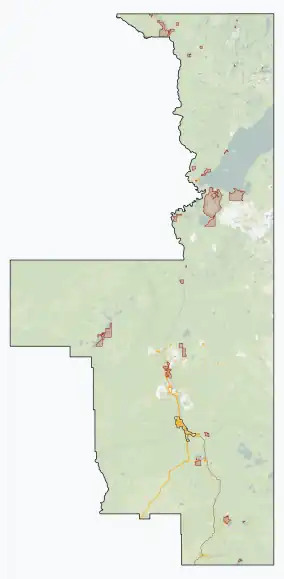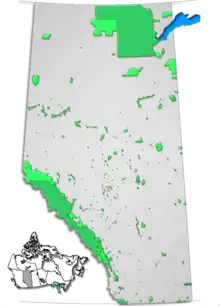Birch Mountains Wildland Provincial Park
Birch Mountains Wildland Provincial Park is a wildland provincial park in northern Alberta, Canada. The park was established on 20 December 2000 with an area of 144,505 hectares (357,080 acres; 557.94 sq mi).[4] On 14 May 2018, the park was enlarged slightly to an area of 145,969 hectares (360,697.25 acres; 563.59 sq mi).[2][3] The park is contained in the Lower Athabasca Region Land Use Framework finalized in 2012.[6] It contains a free roaming wood bison herd. The park is named for the Birch Mountains that are partially contained within the boundaries of the park.[5]
| Birch Mountains Wildland Provincial Park | |
|---|---|
 Location of Birch Mountains WPP  Birch Mountains Wildland Provincial Park (Canada)  Birch Mountains Wildland Provincial Park (Regional Municipality of Wood Buffalo) | |
| Location | Wood Buffalo, Alberta, Canada |
| Nearest city | Fort McKay, Alberta |
| Coordinates | 57°30′30″N 113°0′0″W |
| Area | 145,969 ha (563.59 sq mi)[2][3] |
| Established | 20 December 2000[4] |
| Governing body | Alberta Parks[5] |
Location
The park is located in the Regional Municipality of Wood Buffalo in northeastern Alberta. The park is south of Wood Buffalo National Park, Birch River Wildland Provincial Park, and Kitaskino Nuwenëné Wildland Provincial Park. It borders Alberta Crown land to the north and south and most of the west. It abuts Birch River Wildland Provincial Park in the southwest corner. To the east, the park is adjacent to two Indian reserves, Namur River 174A and Namur Lake 174B, both belonging to the Fort McKay First Nation.[7] The park is very remote; there are no roads to the park. In summer, the only access is the Namur Lake airstrip or via floatplane landing on the lakes in the park.[8] In winter, access is by road, 115 kilometres (71 mi) north of Fort McMurray on Alberta Highway 63 and then private industry roads. Final access is via snowmobile, approximately 20 kilometres (12 mi), on designated trails only.[5]
Ecology
The park protects a segment of the Lower and Upper Boreal Highlands subregions of the Boreal Forest region in the Natural Regions Framework for Alberta.[5] In the National Ecological Framework for Canada used by Environment and Climate Change Canada, the park is in the Birch Upland and North Birch Upland ecodistricts of the Mid-Boreal Uplands ecoregion of the Central Boreal Plains ecoprovince of the Boreal Plains ecozone.[9][10] Under the OneEarth classification (previously World Wildlife Fund), the park is in the Mid-Canada Boreal Plains Forests ecoregion of the Mid-Canada Boreal Plains & Foothill Forests bioregion.[11][12]
Geography
The shape of the park is a rough parallelogram. The east-west base is 62 kilometres (39 mi) wide while the northeast-southwest side is 46 kilometres (29 mi). The terrain is hills with lakes and wetlands in the valleys between. Larger lakes; Namur Lake, Legend Lake, two Gardner Lakes, Big Island Lake, and Sand Lake are found in the east of the park. Many smaller, unnamed lakes are seen throughout the park. The peak elevation in the park is 856 metres (2,808 ft) and the lowest point is 636 metres (2,087 ft) on the north in the Birch River valley.[7][8]
Climate
The Köppen climate classification of the park is Continental, Subarctic (Dfc) characterized by long, cold winters, and short, warm to cool summers.[13] Using the data from a weather station within the park, Legend Auto at the Legend fire lookout tower, for 1991 to 2020, the average daily temperatures exceeds 10 °C (50 °F) only for June, July, and August while average daily temperatures are less than 0 °C (32 °F) for November through March. At Legend Auto, the long-run average precipitation from 1991 to 2020 for the wettest months, June and July, is 80 to 100 mm (3.1 to 3.9 in) per month; conversely, the station receive less than 30 mm (1.2 in) per month from October through April.[14]
Natural history
The area has a remarkably diverse ecosystem that supports lake trout, lake whitefish, cisco, Arctic grayling, walleye, and yellow perch; and many more. Osprey and bald eagles nest in the larger trees around the lakes.[5] The rare, spore-bearing plant quillwort was discovered in the area in 2004.[5][15]
The park is within the range of the Boreal Red Earth Caribou herd.[16]
Activities
There are no developed camping facilities in the park but random backcountry camping is allowed. Other activities in the park include hiking and wildlife viewing. Off-highway vehicle riding is permitted on existing trails only.. Hunting, fishing, and ice fishing are allowed with permits. There are two commercial backcountry lodges in the park: Namur Lake Lodge and Island Lake Lodge.[5]
See also
References
- UNEP-WCMC (2000). "Protected Area Profile for Birch Mountains Wildland Provincial Park from the World Database on Protected Areas". ProtectedPlanet.net. Retrieved 16 January 2023.
- "Plan Showing Birch Mountain Wildland Provincial Park" (PDF). Alberta Parks. 16 May 2018.
- "O.C. 134/2018". Orders In Council. Alberta King's Printer. 14 May 2018. Retrieved 16 January 2023.
- "O.C. 496/2000". Orders In Council. Alberta King's Printer. 20 December 2000. Retrieved 16 January 2023.
- "Birch Mountains Wildland Provincial Park". Alberta Parks. 21 April 2022.
- Lower Athabasca Regional Plan 2012 – 2022 (PDF). Alberta Parks. August 2012. ISBN 978-1-4601-0537-5. Archived (PDF) from the original on 25 September 2012.
- "Alberta Topographic Map" (Map). Topographic-Map.com.
- Namur Lake 84H (PDF) (Map). 1:250,000. Government of Alberta. 2018.
- Terrestrial Ecozones, Ecoregions, and Ecodistricts: Alberta, Saskatchewan, and Manitoba, Canada (Map). 1:2 million. Agriculture and Agri-Food Canada and Environment Canada. 1995.
- Ecological Land Classification, 2017 (PDF). Statistics Canada. 1 March 2018. pp. 4–5, 27. ISBN 978-0-660-24501-0. Catalogue no. 12-607-X.
- Noss, Reed. "Mid-Canada Boreal Plains Forests". OneEarth.org.
- "Mid-Continental Canadian forests". World Wildlife Fund. Retrieved 23 March 2023.
- Atlas of Canada: Climatic Regions (PDF) (Map). Government of Canada. Archived (PDF) from the original on 15 March 2023. Retrieved 23 March 2023.
- "Climate Normals for Alberta: (Legend Auto)". Government of Alberta. 2020. Retrieved 23 March 2023.
- Yatskievych, George (20 March 2020). "quillwort". Encyclopedia Britannica.
- Alberta Caribou Ranges (Map). 1:3 million. Government of Alberta. 2017.
External links
- World’s Largest Contiguous Boreal Land on YouTube
- Wildland Provincial Parks on YouTube
- World’s Largest Boreal Protected Forest (PDF) (Map). Alberta Parks. Retrieved 24 March 2023.
- "World's Largest Boreal Protected Forest". Alberta Parks. 14 November 2018.
- New Park Provides Needed Safeguards for One of Canada's 10 Longest Wild Rivers, World Wildlife Fund, 17 May 2018
- Allen, Lorna; Johnson, J Derek (2007). Small Patch Communities of Birch Mountains Wildland Provincial Park (PDF). Edmonton: Alberta Tourism, Parks, Recreation and Culture. ISBN 978-0-7785-7304-3.
- Cox, Sarah (16 May 2018). "Alberta makes conservation history with new protected areas in boreal forest". The Narwhal.
- Holmberg, Robert; Buckle, Donald (2008). Spiders of Birch Mountains Wildland Provincial Park (Report).
- Thurton, David (15 May 2018). "Alberta now has world's largest expanse of protected boreal forest". CBC News.
